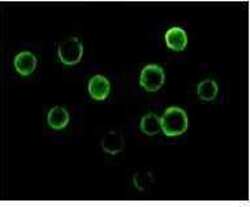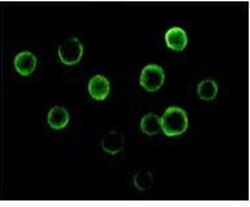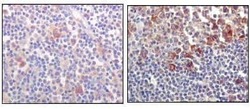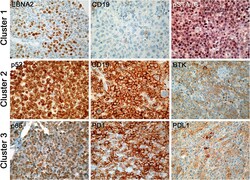Antibody data
- Antibody Data
- Antigen structure
- References [1]
- Comments [0]
- Validations
- Immunocytochemistry [2]
- Immunohistochemistry [1]
- Other assay [1]
Submit
Validation data
Reference
Comment
Report error
- Product number
- MA5-15337 - Provider product page

- Provider
- Invitrogen Antibodies
- Product name
- Btk Monoclonal Antibody (7F12H4)
- Antibody type
- Monoclonal
- Antigen
- Purifed from natural sources
- Description
- MA5-15337 targets BTK in indirect ELISA, IF, IHC, and WB applications and shows reactivity with Human and Non-human primate samples. The MA5-15337 immunogen is purified recombinant fragment of BTK expressed in E. Coli. MA5-15337 detects BTK which has a predicted molecular weight of approximately 77kDa.
- Reactivity
- Human
- Host
- Mouse
- Isotype
- IgG
- Antibody clone number
- 7F12H4
- Vial size
- 100 μL
- Concentration
- Conc. Not Determined
- Storage
- Store at 4°C short term. For long term storage, store at -20°C, avoiding freeze/thaw cycles.
Submitted references Comprehensive phenotypic characterization of PTLD reveals potential reliance on EBV or NF-κB signalling instead of B-cell receptor signalling.
Menter T, Dickenmann M, Juskevicius D, Steiger J, Dirnhofer S, Tzankov A
Hematological oncology 2017 Jun;35(2):187-197
Hematological oncology 2017 Jun;35(2):187-197
No comments: Submit comment
Supportive validation
- Submitted by
- Invitrogen Antibodies (provider)
- Main image

- Experimental details
- Immunofluorescence analysis of Jurkat cells using BTK monoclonal antibody (Product # MA5-15337)
- Submitted by
- Invitrogen Antibodies (provider)
- Main image

- Experimental details
- Immunofluorescence analysis of Jurkat cells using BTK monoclonal antibody (Product # MA5-15337)
Supportive validation
- Submitted by
- Invitrogen Antibodies (provider)
- Main image

- Experimental details
- Immunohistochemical analysis of paraffin-embedded human lymph node tissues (left) and human lymph follicle tissues (right), showing cytoplasmic and membrane localization using BTK monoclonal antibody (Product # MA5-15337) followed with DAB staining.
Supportive validation
- Submitted by
- Invitrogen Antibodies (provider)
- Main image

- Experimental details
- Immunohistochemical stainings of various markers, which were differently expressed in the three phenotypic clusters. First row (from left to right): cases of cluster 1 showing expression of EBV nuclear antigen 2 (EBNA2) (360x), lacking expression of CD19 (non-neoplastic lymphocytes serving as positive internal control; 400x), and expressing pSTAT6 (360x). Second row (from left to right): cases of cluster 2 showing expression of p52 (400x), CD19 (400x) and Bruton tyrosine kinase (BTK) (360x). Third row (from left to right): cases of cluster 3 showing expression of p65, PD1 and PDL1 (all 360x)
 Explore
Explore Validate
Validate Learn
Learn Western blot
Western blot ELISA
ELISA Immunocytochemistry
Immunocytochemistry